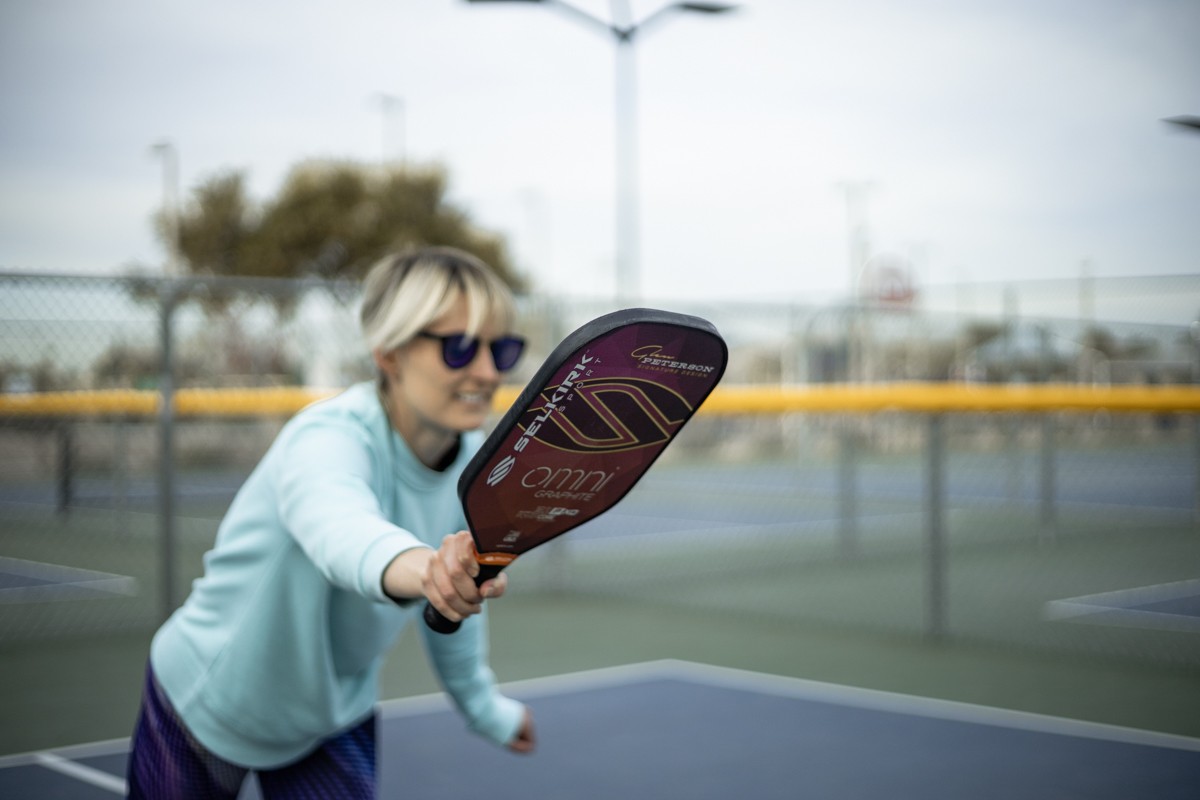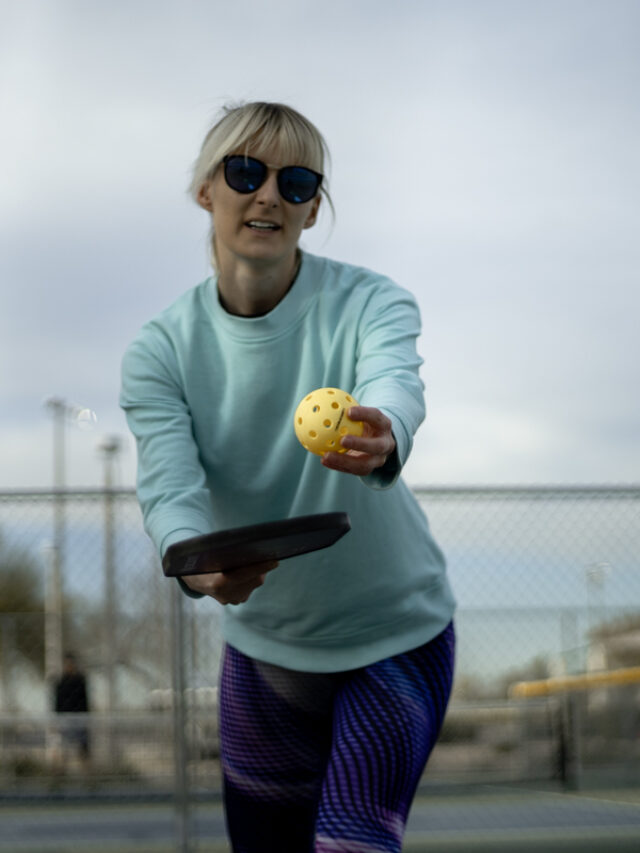
Think you know how to hit a pickleball? Here are the best ways to have control.
Whether you’re hitting a groundstroke, a volley, or a dink, knowing how to hit a pickleball effectively will improve your game tremendously.
But how do you hit a pickleball properly?
You can master hitting a pickleball by knowing some fancy footwork, using your whole body effectively, keeping your eye on the ball, knowing how hard or soft you should hit the ball, planning the ball’s placement, and monitoring the contact between the pickleball and your paddle.
Whether you’re a new or more experienced pickleball player, hitting a pickleball with maximum control will make a huge difference to all of your pickleball games.
Knowing how to hit a pickleball comes down to one key tactic that advanced players use all the time in their pickleball strategy: keeping the ball low.
Hitting the ball too high is a common mistake among casual pickleball players.
Keeping the pickleball ball is the best way to maintain more control over your stroke since you will not need to overextend yourself too much.
Professional pickleball players use their whole bodies to execute the perfect shot, using the kinetic chain they form by “coiling” up their bodies in preparation for the shot.
Here’s everything you need to know about how to hit a pickleball to use this to your advantage next time you step onto the pickleball court.

This post contains affiliate links, including Amazon Associates links, and we may receive a small commission if you use one. This is at no extra cost to you and allows this site to continue providing free pickleball resources.
How To Hit A Pickleball: Step By Step
How you hit a pickleball depends on what type of shot you need to make.
However, there are certain principles to consider before hitting a pickleball.
1. How Your Feet Can Help You Hit A Pickleball
Your feet and legs must be ready to take you to your next shot.
Wearing the right shoes, keeping light-footed and having a “spring in your split-step” is helpful when you want to hit a pickleball without overextending yourself.
The closer you are to the pickleball ball, the better your chance of controlling how hard, soft, low, or high you want to hit it.
A split step helps you to recover your position after a shot and prepares you for your next shot.
Split steps are more effective if you are on the balls of your feet instead of flat-footed (which is why having the right shoes is so important!).
By being nimble on your feet, you can move fractionally to the left or right or step forward or backwards so that you can hit the pickleball without stretching your hitting arm out.
If you are in the non-volley zone, the chances are your split steps will be bigger to help you cover more distance.
The closer your proximity to the pickleball net, the smaller your split steps will likely be.
2. How To Use Your Torso To Hit A Pickleball
To hit a pickleball with more control, you should use your torso – that is, the area from the hips to your shoulders.
Coiling or turning your hips and shoulders towards your next shot allows you more control when hitting a pickleball.
As you uncoil, the kinetic chain upsprings itself, and you gain power are more control over your shot.
This can feel a little unnatural at first, but most pickleball players get used to it in no time at all.
3. How To Use Your Arms To Hit A Pickleball
Ideally, your hitting arm should not be fully extended when you hit a pickleball because you can lose control of the force and trajectory of the ball.
Your hitting arm should be slightly bent, and when you hit the ball, the arm movement should start from your shoulder.
You will have a more fluid, powerful, and controlled swing using your whole arm.
This technique applies to any shot in pickleball, whether hard shots using a forehand, backhand, drive, or drop shot, or one of the softer shots like drops, dinks, resets, or blocks.
Your off arm is used to help you to turn, set up for your next move, and stabilize your hitting arm.
When you use a backhand position, your off arm offers a counterbalance for your dominant arm.
4. Watch The Ball Until It Makes Contact With The Paddle
Some pickleball players mistake looking up too soon at their target, thereby hitting the ball incorrectly or missing it altogether.
When you want to hit a pickleball effectively, it is good practice to keep your eyes on the ball until it makes contact with your paddle.
By watching the ball until contact is made, you are more likely to control how you hit the ball and avoid unforced errors.
Watching the ball make contact with your paddle is easier if you are further away from the net.
When you are close to the net, the ball is coming to you more frequently, which makes it difficult to keep a close eye on the ball.

How To Keep The Ball Low In Pickleball
Hitting a high ball in pickleball is like offering your opponent points.
A high ball is considered an “attackable ball” because your opponent can hit back with an aggressive shot.
Therefore, low balls are usually better and learning to keep the ball low is one of the easiest ways to become a better player.
By keeping the pickleball ball low, you will almost force your opponent to hit high shots, allowing you to attack.
So, as you can see, a low ball is the way to go in most cases when it comes to how to hit a pickleball.
But how do you keep the ball low in pickleball?
Here’s how to hit a pickleball lower in four easy steps:
1. Your Paddle Position Should Be Closed Or High-To-Low
The closed position of the paddle is perpendicular to the ground.
If you hit a pickleball with a closed paddle, it should travel parallel to the ground.
A high-to-low position is when you tilt the top of your paddle slightly forward and down—hitting the ball in this position so that the ball’s trajectory will be a straight low to the other side of the net.
2. Minimize Ground Shots That Will Cause You To Hit The Ball High
If you need to scoop your paddle upwards to save a shot, you will hit the ball high, which you probably want to avoid.
Once you have recovered the ball from a low position, you can keep the ball neutral-to-low by tilting the top of your paddle slightly forward and down in the high-to-low position mentioned above.
3. Hit The Ball Early, From In Front Of You
You have more control over how low or high you will hit the ball if you hit it before it passes you.
This is is why it’s important to always be in the proper ready position when waiting for the opposing team to return the ball.
If you must twist or reach back to hit the ball, it is more likely that you will hit a high ball, so get to the ball as early as possible so you can hit the ball while it is in front of your body.
4. Check The Pressure Of Your Paddle Grip
In the throes of a pickleball match, you may tense up and tighten your grip on your paddle.
If you tighten your grip too much, it could affect the angle of the paddle.
Make sure you periodically check how tight you are holding the paddle and the angle of it and adjust accordingly.
If you need help choosing the best pickleball paddle for you, you can check out our handy guide here.
Bestselling products from the Pink Pickleball store:
How Do I Stop Hitting High Balls In Pickleball?
Are you guilty of popping the ball into a rainbow arc often?
It can be frustrating and cost you a lot of points, so you want to fix that as quickly as possible.
You are likelier to hit a ball high in pickleball if you have to “pop” it.
Popping the ball means less touch or control over the way you hit it.
You can stop hitting high balls if you stop popping the ball up.
Read on to see why you are popping the ball up and how to stop doing it.
Why Do I Keep Popping The Ball Up In Pickleball?
You may be popping the ball up for one of many reasons.
However, the following four reasons may indicate why you keep popping the pickleball up.
1. You May Be Tense, Restricting Your Swing And Focus
Loosen up a bit and avoid tensing up.
A tense body will restrict your swing and distract your focus – even if you have a good position – which might result in you hitting more high balls.
2. You Might Be Holding The Paddle Grip Incorrectly
Check your paddle grip.
Are you holding your paddle in the closed position, or is it tilted more towards an open position (face up)?
A closed position is less likely to pop your ball upwards and gives you the best shot at returning the ball lower.
One of the easiest ways to achieve this is by using a continental grip.
3. You Don’t Get To The Ball In Time To Prepare A Strike
Try to get to the ball early, so you have more time to prepare for your strike.
Playing on the attack is preferable to playing defensively (plus it’s great exercise!).
4. You Have To Save The Ball To Keep In The Game
Although it can’t always be helped, avoid shots where you must save the ball close to the ground – especially in the middle of the court.
Shots such as these require height to get the ball over the net, resulting in those unwanted high, popped balls.
How Do You Hit A Soft Shot In Pickleball?
To hit a soft shot in pickleball is a skill many beginners undermine.
Some soft pickleball shots include dinks, drops, resets, or blocks.
- To hit a dink, your paddle must be in front of your chest and in a closed position, i.e., facing forwards, and you need to stand in a ready position just behind the kitchen line
- As the ball approaches you, move to the ball using quick, small steps. Bend low and maintain your balance.
- As you reach for the ball, your paddle face should now be open (facing upwards). Step forward with your dominant foot.
- Scoop the ball low to the ground, using a lifting action to get it over the net.
- A dinking game might seem slow because it requires a delicate and soft touch instead of slamming. Be patient; you will have an opportunity to strike.
Learning how to hit a pickleball
Learning how to hit a pickleball effectively might sound straightforward, but is something a new player can easily overlook.
As you can see, though, it can be the difference between a winning shot and giving the receiving team an easy time.
Practising a variety of pickleball shots won’t just make you a more experienced player by allowing you to progress beyond the basic strokes.
It will also give you much greater control and a strategic advantage whether you are on the serving team or preparing for the return of serve.
After all, when you have more control over your paddle angle and how the ball bounces, it’s much harder for an opposing player to catch you off guard – and, oftentimes, that is the only way to secure a win.
creditSource link






